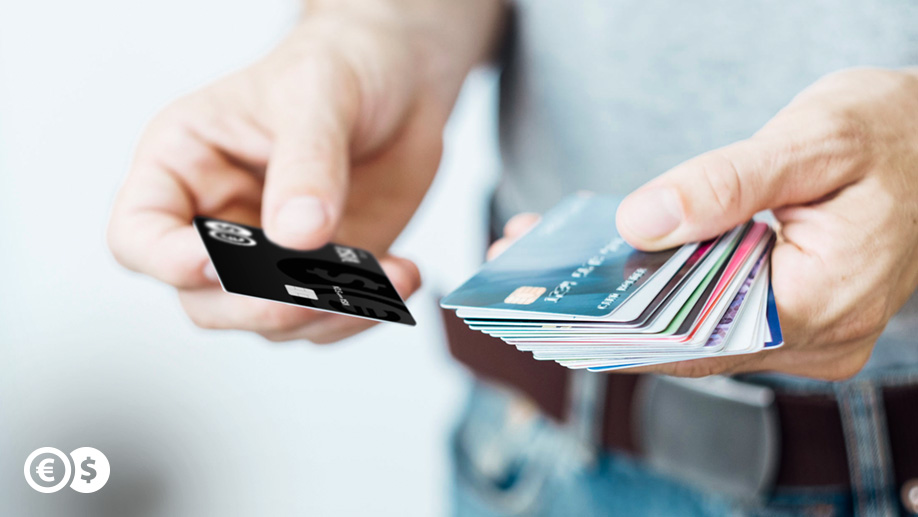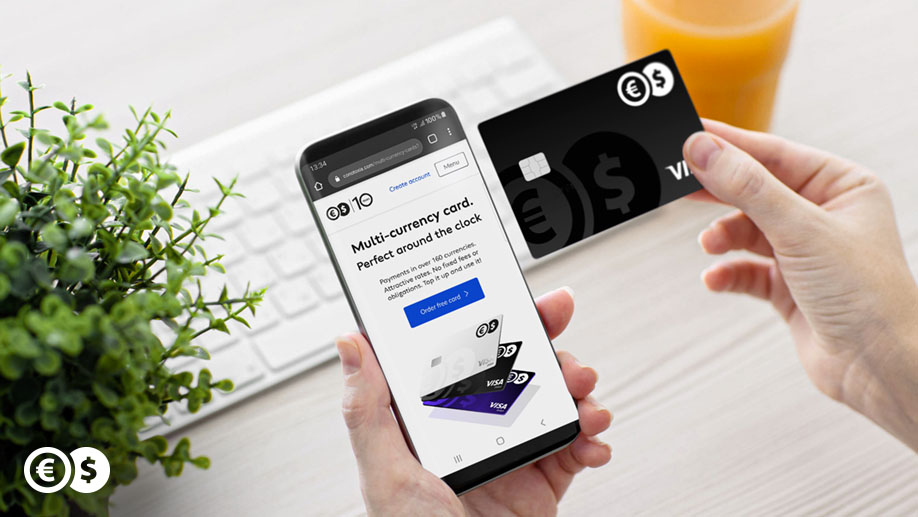Are you planning online shopping in a foreign currency? The proper choice of payment card will help you save a lot of money. However, the rich offer of banks and fintech companies may be confusing, so here we explain the basic assumptions of the services available on the market.
A few years back, our preparations for a journey abroad started (or ended) with a visit to the currency exchange office and converting money into the currency of the country we were travelling to. Today, fortunately, this is an optional element, because we can conveniently pay with one of the multi-currency cards while being abroad. Such a solution often means not only a greater travel comfort but also savings resulting from better exchange rates.

Multi-currency card and a bank account
The basic type of multi-currency card, which we can use to pay worldwide in different currencies, is the one issued to a bank account. Most of the banks have introduced this service to their offer in recent years.
How does it work? In a selected bank, we create accounts in currencies that interest us. In the past, we would get a separate payment card for each of them, which would linger in the wallet. Today, some banks issue only one card, which is assigned to several accounts at once.
When you are abroad, all you have to do is pay with your card, and the system will automatically recognize the currency of the transaction and take funds from the appropriate currency account. Therefore, if you carry out transactions in EUR, the funds will be taken from your account held in EUR.
There is no doubt that this is a much more convenient and, by the way, also a safer solution than carrying cash in your wallet or dealing with several cards — each to a separate bank account.
However, a multi-currency card still comes with flaws. We must remember to have funds to cover the transaction on a given account in a particular currency. Otherwise, the bank will take money from the account in another currency, which may involve a currency conversion commission or, for example, a less attractive exchange rate.
Moreover, for instance, in some banks in Poland, the multi-currency cards are usually issued only to the main currencies — the euro, the US dollar, the British pound or the Swiss franc. Definitely less often the card can be associated with several currencies, including the less popular ones.
Of course, it does not mean that such a card cannot be used to pay in other currencies, either. Yet, in such a case, there may be a double currency conversion. If our card supports only five currencies, and we want to pay in, e.g. the Thai baht, the amount will first be converted at the rate of the payment provider (usually Visa or Mastercard) to dollars, and then from dollars to the currency in which we maintain the account. Information on how this mechanism works is always included in the Terms and Conditions of the card.
What fees can we expect for such a card? Some banks may charge monthly costs for running an account in certain currencies. However, they can usually be avoided by providing a fixed income to the account or by making payments during the month for the amount specified in the regulations. This can be, for example, 100 USD.
Moreover, it is worth checking what rates the bank uses and whether there are any additional charges related to currency conversion. One should also check the Terms and Conditions regarding the usage of a multi-currency card, the costs of its operation or, for example, cash withdrawals from foreign ATMs. All this affects the final verdict, whether the offer is attractive.
Multi-currency cards for foreign currency accounts have entered the banks' offer worldwide. In some banks, customers do not even need to order additional multi-currency cards. One simply activates the appropriate function so that the card dedicated for payments in, for example, the Polish zloty or the Hungarian forint, is also assigned to the foreign currency accounts.
Multi-currency card offered by fintech as an alternative
Some fintech companies - e.g. Conotoxia.com or Revolut - have an alternative to currency cards on offer. Issued by them payment cards operate on a similar basis as those described above.
However, the consumer may gain access to more currencies. Of course, it is possible to pay in about 160 currencies around the world. Direct payments in a given currency, without currency conversion of the payment provider involved, are usually possible in a dozen or so currencies.
For example, the Conotoxia multi-currency card offers access to free accounts in 20 currencies and payments in more than 160 currencies. Therefore, users avoid currency conversion fees. For comparison: banks usually offer the possibility to connect only 3-4 currency accounts to one card. They also require a fee for having it.
Therefore, the card user is able to use several dozen currency accounts, between which they can exchange currency and pay worldwide at any time.
What is more, in the case of cards issued by an online currency exchange bureau, an automatic currency conversion mechanism is available. What does it mean? Before making a transaction, we do not have to remember to provide funds for payment execution in a given currency. It is enough for us to have funds on one of the currency accounts. Then the card will automatically convert the money at a usually attractive rate.
A multi-currency card provided by an online currency exchange bureau is advantageous in other respects. Usually, it is free — the only cost we have to bear is for ordering and issuing the card, although here too you can meet a promotion, thanks to which you will receive it for free.
Additionally, there is no requirement for you to have a fixed or monthly income on your account, etc. Managing payment accounts in different currencies is entirely free of charge. For example, Conotoxia.com does not require regular payments. Therefore, nothing stands in the way for a customer to use a multi-currency card occasionally, e.g., twice a year during holiday trips or online payments. Fintech also does not charge fees for card usage, payments in many currencies, foreign currency accounts, card top-ups or transferring funds from a currency wallet. It also offers fee-free ATM withdrawals worldwide up to a set limit. So it's a great alternative to foreign cards, which can charge extra fees.
Payments using multi-currency card
No fees associated with the maintenance of foreign currency accounts make such an account completely costless regardless of how we use it. This is an excellent opportunity to use, e.g. Conotoxia multi-currency card for payments in EUR at home, treating it as an alternative to a traditional payment card.
In this case, it works like any other debit payment card. If you have money on the card, you can use it to pay for purchases anywhere such payments are accepted — in a supermarket, local store, grocery store, the Internet, etc.
A multi-currency card can, therefore, prove to be a universal means of payment, regardless of whether you buy strawberries from a local seller or coffee in an airport lounge in Bolivian Santa Cruz.
Besides, it is safe to use. What distinguishes Conotoxia's offer is the solution of separating the account balance from the card balance. This way, customers can keep only as much money on the card as they need at a given moment. They can transfer a given amount from their wallet to the card at any time. Such top-ups are free and instant. Thus, the model developed by fintech encourages taking control over the budget. The user can keep only the funds for current expenses on the card and leave the rest in the currency wallet.
A card on your phone that you won't lose

Virtual currency cards are a separate category. It is effortless to register them — all you have to do is enter the required data to assign them to your account within moments.
A virtual card, as the name suggests, has no physical form. Besides, it does not differ from a physical card in any way — it has its own number and CVV/CVC security code. Therefore, it can be used to pay on the Internet just like a regular card. The difference, however, is that instead of in your wallet, you will find it in your phone.
The benefits of such a solution? You will never lose it. You can also set up new virtual cards for specific purposes — e.g., paying for a streaming service on the Internet. You can also impose monthly limits on them to serve only in this particular situation.
Nothing prevents you from paying with your virtual card in stationary shops. Thanks to the integration with Apple Pay, Google Pay, Fitbit Pay and Garmin Pay, you can make contactless payments with your smartphone, watch or band.
If you often pay online, you are undoubtedly aware that sometimes data related to payment cards are leaking. In this circumstance, cybercriminals may come into possession of your card number and use it in illegal transactions. If you already have a virtual card, you need to restrict it and then make a new one in a few moments, the numbers of which are known only to us.
Another advantage of virtual cards is the pace of their issuing and top-up. A user of Conotoxia.com can receive this means of payment on the Internet in just 30 seconds — it will more or less take this long to assign it to an already existing account. Topping up the card will be equally comfortable — one just has to transfer the funds available in the currency wallet to it. Also, there are other ways to top up the card, for example, by using fast and convenient payment methods. Therefore, the Conotoxia multi-currency card is an attractive alternative to the offers of fintech companies worldwide.
Virtual cards are still relative novelties on the market. This service is available for free on Conotoxia.com. Similar solutions are also offered by Revolut or banks in Poland, although the last ones may charge fees for its issuance.



